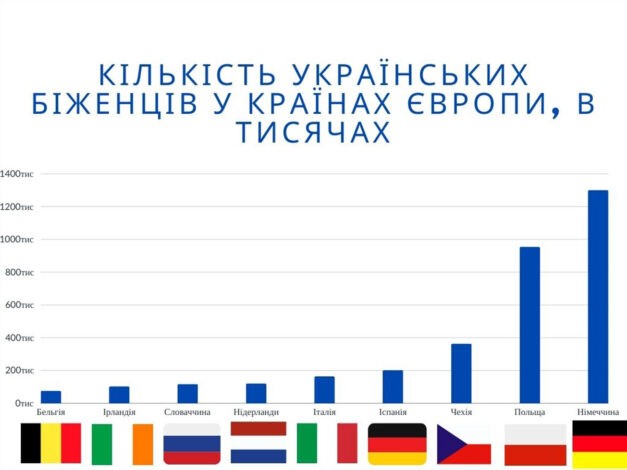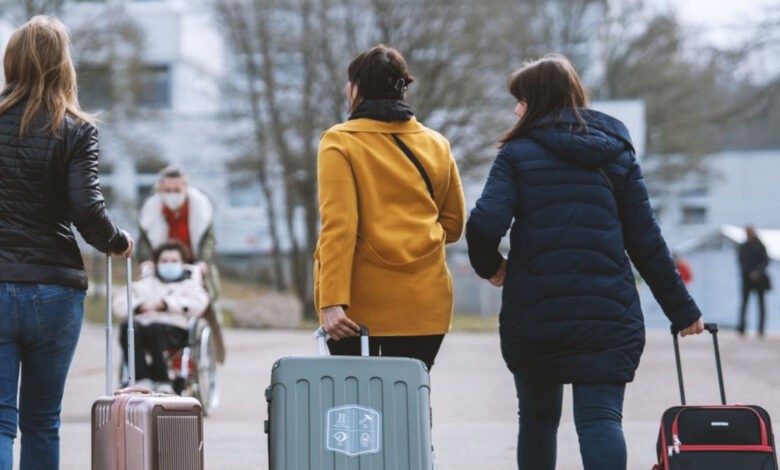People are after money, and in Germany they are calling for a proportional distribution of Ukrainian refugees

Germany is a country where, as a result of secondary migration, the number of Ukrainian refugees is constantly increasing. Since the beginning of the full-scale invasion, it has increased from 156 thousand to 1.38 million people. This is the largest indicator among recipient countries in Europe. The federal government is thinking about slowing down the flow of Ukrainian migrants to Germany. A spokeswoman for the Federal Minister of the Interior, Nancy Feser, said that Germany is “resolutely committed to the principle of solidarity sharing of those seeking protection”. She believes that the search for solutions is especially necessary against the background of secondary migration from EU member states to Germany.
Current Eurostat data provide an opportunity to see all the diversity of the disproportionate distribution of Ukrainians across European countries – from tens of thousands to a million, and to think about the reasons for uneven migration.

Why Germany?
Asylum-seekers receive social assistance here, which amounts to 563 euros per month. In other countries, the amount to support refugees is much lower. The figures became known after the data were made public Analysis of scientific services of the Bundestag, commissioned by CDU deputy and head of SME and Economic Union Gitta Konnemann. They caused a significant resonance in the media and among politicians and forced comparisons. And this comparison was obviously not in favor of thrifty Germany.
Yes, in Sweden, single Ukrainian refugees receive only a daily allowance in the amount of 180 euros per month, an additional 30 euros of housing allowance is provided, special assistance is also possible, but under special conditions. In Poland, however, Ukrainians do not have the right to permanent financial assistance at all; they are only given initial support in the amount of 70 euros, in addition, there are individual programs for families and individuals in difficult life situations. Austria provides assistance of up to 260 euros per month to single Ukrainians, while rent costs can be subsidized up to a maximum of 165 euros. In the Netherlands, they receive an allowance of 384 euros per month. In Italy, this amount is 300 euros, in France – 426 euros. In Finland, there is a “reception allowance” of €349 per month, and a basic social allowance of €587 per month for refugees who are permanently resident in the country.
In Norway, the amount of support is slightly higher than in Germany – 670 euros. There is also an “entry allowance” of around €17,300 per year if the applicant works full-time. This approach encourages Ukrainians to get to work. At the same time, Germany has one of the lowest percentages of those who are employed. Only every fifth Ukrainian works here. For comparison: more than three quarters of Ukrainians are employed in Denmark, two thirds in Poland and the Czech Republic, and more than 50 percent in the Netherlands, Sweden and Great Britain.
Money is a trap for Ukrainians
Critics of excessive support for Ukrainian refugees (CDU, CDSU and liberals) see a direct connection between the high level of payments and reluctance to get a job. They talk about money as a trap for Ukrainians that prevents them from fully integrating into German society.
On the other hand, social democrats do not see a problem in the reluctance of Ukrainians to work. In their opinion, the program „Job-Turbo“ works successfully. The press secretary for labor market policy Martin Rosemann, in particular, states: “Currently, we see that the number of employed Ukrainian refugees is constantly increasing. Since November 2023, the number of vacancies registered with the Federal Employment Agency that can be filled by immigrants has almost doubled.”

It is noteworthy that for Germans, secondary migration signals the intention of Ukrainian refugees to stay in Germany, which is logically connected with the desire to integrate into German society. Therefore, considerations about migration processes in the country are often accompanied by sincere surprise regarding Ukrainian indifference to work.
It is enough to look at the titles of quality German publications.
Why are so few Ukrainian refugees working in Germany? (Deutsche Welle)
Ukrainian refugees: Hardly any country is as generous as Germany (Die Welt)
Why are units of refugees from Ukraine still working? (Tageblatt)
Why do many Ukrainian refugees still live in shared housing? (MDR)
Optimistic models of the labor market
Labor Market Institute and professional research models the initiative of Ukrainian migrants regarding employment for the coming years. Under the baseline scenario, Ukrainian refugees reach an average employment rate of 45 percent after five years in Germany and 55 percent after ten years.
Such models look more like a way of self-satisfaction by the Germans, who, it seems, sincerely cannot understand why Ukrainians, who have made a choice in favor of their country, are in no hurry to take up work, of which there are so many in the country.
Herbert Brucker of the Institute for Labor Market and Vocational Studies attributes this in part to the “extremely high level of education” of Ukrainian refugees, higher than in Ukraine as a whole and higher than in Germany. It is about more than 70 percent of those with higher education and more than 10 percent of those with professional technical qualifications. Such indicators obviously do not contribute to the employment of Ukrainians in the so-called “black” work.
Recently, gender specificity has also become apparent in the attitude towards Ukrainian refugees. According to the Central Register of Foreigners, 256,000 Ukrainian men of military age live in Germany today. Bavarian Interior Minister Joachim Herrmann, who represents the CSU, calls them “deserters” and calls for the withdrawal of cash payments. Instead, the Minister of Internal Affairs Georg Mayer of Thuringia, who belongs to the Social Democrats, criticizes his colleague’s choice of words and intentions, considering it absurd to call all Ukrainian men abroad evasive.
A way out of the migration crisis?
The issue of Ukrainian refugees has remained in the focus of German politics since the beginning of the full-scale invasion.
Despite significant difficulties and achievement of quotas for accepting refugees by many countries, the acceptance of our citizens who are looking for safe living conditions continues.
According to a special analysis by the Federal Statistical Office, more immigrants arrived from Ukraine in the first half of 2022 alone than in 2015-16 from Syria, Afghanistan and Iraq combined, which gave the German government grounds to declare a migration crisis.
The reasoning of German high-ranking officials regarding the proportional distribution of Ukrainian refugees across European countries is fully motivated. When, in the spring of 2022, municipalities reached the limit of their capacity to accommodate newly arrived refugees from Ukraine, the question of a fair distribution of Ukrainians across federal lands arose. Now it has gone beyond the borders of the country and, obviously, needs a cross-border solution.





